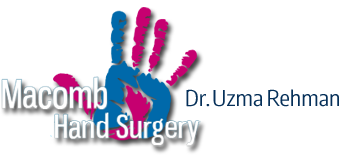When to See a Doctor for Fingernail Problems
Fingernails can be beautiful fashion statements. But let’s not forget that, first and foremost, fingernails are designed to protect the ends of your fingers. When fingernail problems arise, the result is not only be unsightly hands. Damaged or diseased fingernails can present mild to serious health problems that should be addressed, so that the situation does not worsen.
At Macomb Hand Surgery in the Clarkston, MI area we understand that all of us are trying to avoid unnecessary trips out during social distancing. This means only going to the doctor’s office for necessary procedures. So, in this article Clarkson, MI hand specialist Dr. Uzma Rehman provides some tips for deciding when you need to see a doctor for fingernail problem. and when “it can wait”.
But remember we are always here to see you – practicing the safest COVID-19 protocols, so that any condition of your hand, wrist, arm or fingernails does not develop into something worse or more painful. Early diagnosis and intervention is always the best way to ensure rapid recovery and prevent long term problems.
What are Fingernails?
Fingernails are composed of layers of a hardened protein called keratin. Keratin is also present in your hair and your skin. Noticeable changes in the nails can be a cosmetic problem, but can also indicate more serious health issues.
Fingernails with noticeable ridges, dents or areas of unusual color or shape can be signs of a problem. Vertical ridges tend to increase with age, and are less-concerning than horizontal ridges. White lines or spots can occur if the nail has been injured, but if these grow out, as the nail grows and heals, they are also not a cause for concern.
When to See a Doctor for Fingernail Issues
Fingernail conditions that typically require consultation with a doctor include:
- Changes in nail color
- Discoloration of the nail or a dark streak in the nail
- Brittleness, cracking or crumbling at the outside edges of the nail
- Changes in the shape of the nail
- Curling or thickening of the nails
- Separation of the nail from the surrounding skin
- Bleeding or swelling/pain around the nails
Common Fingernail Problems
Any of the above conditions could indicate the presence of a bacterial or fungal nail infection. And, as with any infection, fingernail infections should be treated with medication. Failure to treat a fingernail infection can lead to permanent damage or even loss of the fingernail, as well as a spread and worsening of the infection.
Typically over-the-counter remedies won’t be strong enough to treat a serious fingernail infection, so self-diagnosis and treatment is not recommended. Consultation with a hand doctor who is specially trained to recognize, diagnose and treat fingernail disorders is important.
And, just as the “eyes are windows to the soul” fingernails are often “windows to the body” – providing insights into underlying medical conditions that the patient may not even know they have. Fingernail discoloration or changes in shape or thickness can also be the first signs of a more serious illness or disease.
Changes in Fingernail Texture
Split fingernails can also be the result of a deficiency of folic acid, and/or vitamin C, and/or protein. While pitted nails can be a sign of psoriasis, which often starts in the nails.
Thick fingernails, however, can be a sign of lung disease, or an underlying circulation problem. And thick nails that also separate from the nail bed may indicate that the person is suffering from thyroid disease or psoriasis.
Changes in Fingernail Color
Yellow fingernails can be a sign of a more serious medical condition, including respiratory disease, chronic bronchitis, rheumatoid arthritis, and in rare case certain cancers.
Similarly, white nails should never be ignored as they can also can be a sign of a more serious underlying medical condition, including: diabetes, liver disease, congestive heart failure, or kidney failure.
Changes in Fingernail Shape
Fingernails that curve up and away from the nail beds are sometimes called “spoon nails“. This can be symptomatic of iron deficiency anemia, or the liver condition hemochromatosis, in which the body absorbs too much iron from food.
If the tips of the fingers enlarge and the nails curve around the fingertips, this is called “nail clubbing“. It should never be ignored as it is frequently due to a serious underlying condition. It is often associated with lung disease, inflammatory bowel disease, heart disease, liver disease and in some cases AIDS.
Top Clarkston Area Fingernail Doctor
Board certified Clarkston area hand and fingernail doctor, Dr. Rehman is trained to evaluate and treat conditions affecting the nails. In many cases prescription oral anti-fungal or anti-bacterial medication is all that may be required. If the nails are in-grown, Dr. Rehman will be able to provide relief and speed the healing of this painful condition as well.
But remember, fingernails aren’t just a fashion statement; they are indicators of your overall health and wellness. Contact Dr. Rehman today for a full evaluation and comprehensive treatment program that will return your nails to their healthy state – and help identify any underlying medical issues rapidly, so that it can be treated as early as possible.
Doctor Rehman will assess your individual situation, and prescribe the treatments that are best for your condition.

